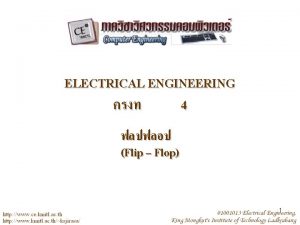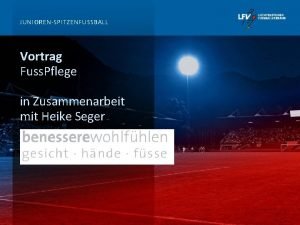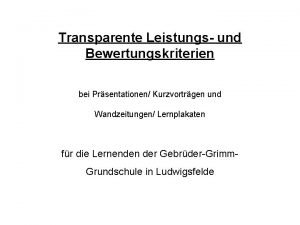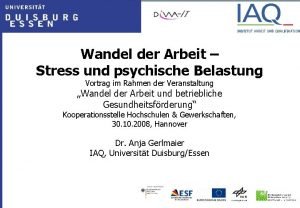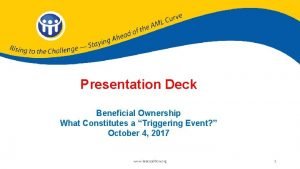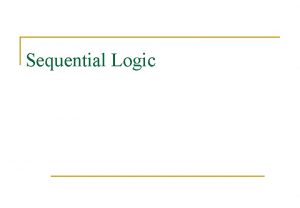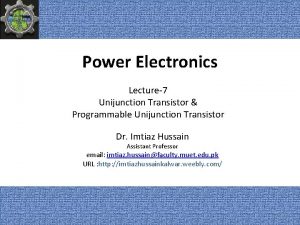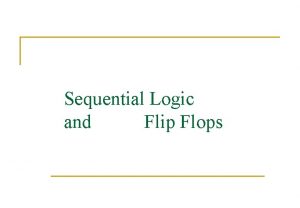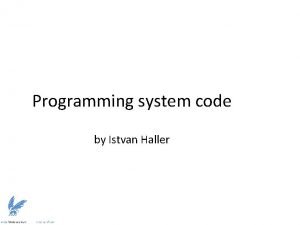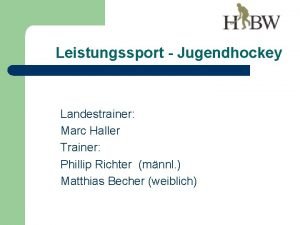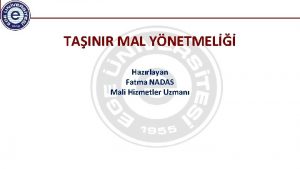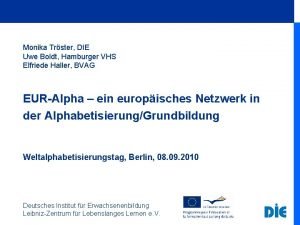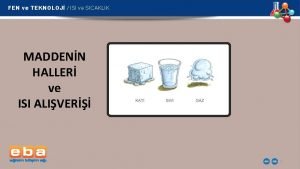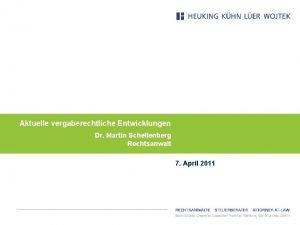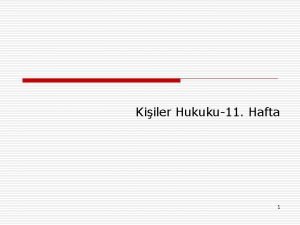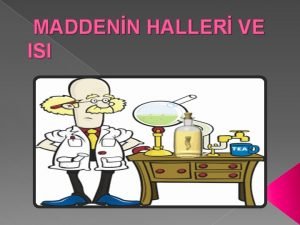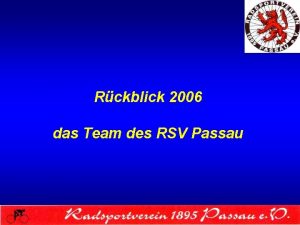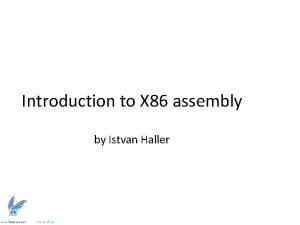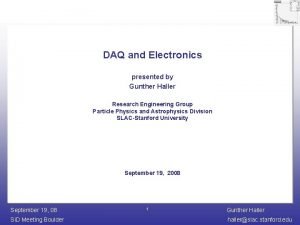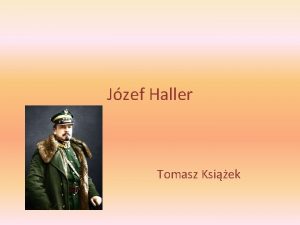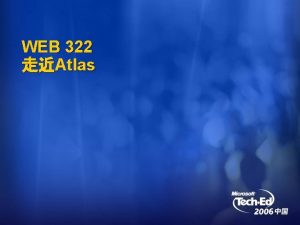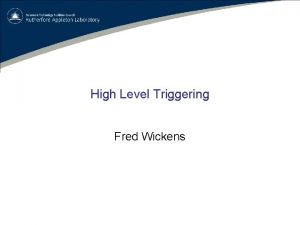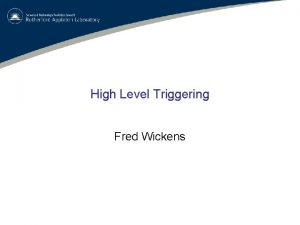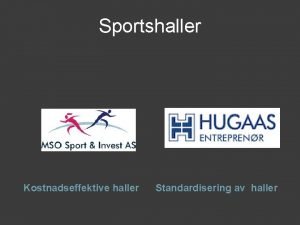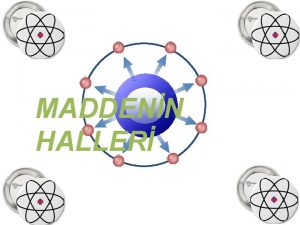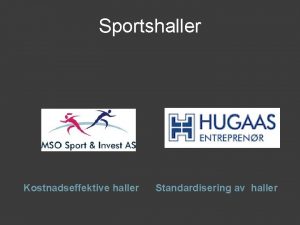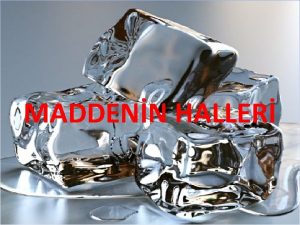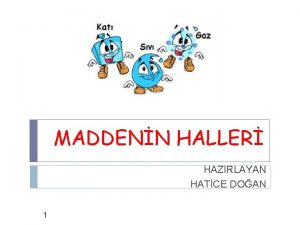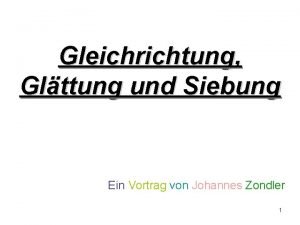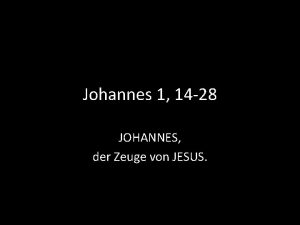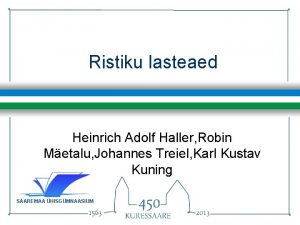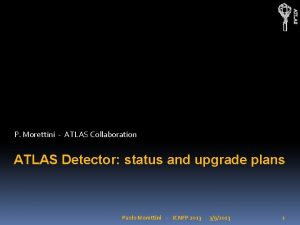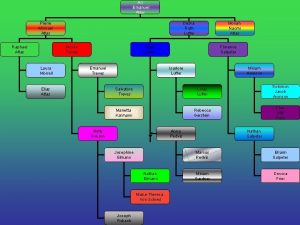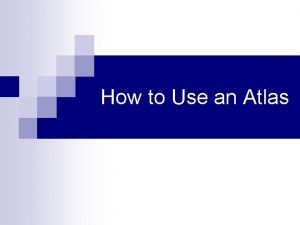Triggering at ATLAS Vortrag von Johannes Haller Uni





























- Slides: 29

Triggering at ATLAS Vortrag von Johannes Haller, Uni HH Am ATLAS-D Meeting, September 2006 Ø Trigger Challenge at the LHC Ø Technical Implementation Ø Trigger Strategy, Trigger Menus, Operational Model, Physics Analyses and all that Martin zur Nedden, HU Berlin Trigger bei Atlas 1

Physics Goals at the LHC EW symmetry breaking ? - search for the Higgs Boson p µ+ µ+ HZ g µ- p H p Z µ- p g eq Extensions of the Standard Model ? - search for SUSY or other BSM physics ~ q ~ g p ~ q q What else? - top, EW, QCD, B-physics ~ c 20 ne c 1 q p m+ m ~c 0 1 “The” trigger question: - physics events: m, g, e, t, jets, ET, miss What events do we need to take? - monitor events - calibration events Martin zur Nedden, HU Berlin -high p. T objects (un-pre-scaled) -low p. T objects (pre-scaled or in exclusive selection) Trigger bei Atlas e l simp er? w s an 2

Event Rates and Multiplicities cross section of p-p collisions R = event rate = luminosity = 1034 cm-2 s-1 inel = inel. Cross section = 70 mb N = interactions / bunch crossing Dt = bunch crossing interval = 25 ns tot(14 Te. V) ≈ 100 mb inel(14 Te. V) ≈ 70 mb LHC cm energy (Ge. V) R = x inel = 1034 cm-2 s-1 x 70 mb = 7· 108 Hz N = R / Dt = 7· 108 s-1 x 25· 10 -9 s = 17. 5 x 3564 / 2808 (not all bunches filled) = 23 interactions / bunch crossing (pileup) With every bunch crossing 23 Minimum Bias events with ~1725 particles produced Martin zur Nedden, HU Berlin Trigger bei Atlas nch = charged particles / interaction Nch = charged particles / BC Ntot = all particles / BC nch ≈ 50 Nch= nch x 23 = ~ 1150 Nto= Nch x 1. 5 = ~ 1725 3

Looking for Interesting Events Higgs → ZZ → 2 e+2 m Martin zur Nedden, HU Berlin Trigger bei Atlas 23 min bias events 4

another Constraint: ATLAS Event Size pile-up, adequate precision need small granularity detectors Detector Channels Fragment size [KB] Pixels 1. 4*108 60 SCT 6. 2*106 110 TRT 3. 7*105 307 LAr 1. 8*105 576 Tile 104 48 MDT 3. 7*105 154 CSC 6. 7*104 256 RPC 3. 5*105 12 TGC 4. 4*105 6 LVL 1 28 Atlas event size: 1. 5 MB (140 million channels) at 40 MHz: 1 PB/sec affordable mass storage: 300 MB/sec storage rate: < 200 Hz 3 PB/year for offline analysis Martin zur Nedden, HU Berlin Trigger bei Atlas 5

The Trigger Challenge σ rate total interaction rate IA rate: ~ 1 GHz; BC rate: 40 MHz; storage: ~ 200 Hz online rejection: 99. 9995% (!) crucial for physics (!) powerful trigger needed: • enormous rate reduction • retaining the rare events in the very tough LHC environment discoveries storage rate • remember: 0. 000005 must be shared: ET Martin zur Nedden, HU Berlin Trigger bei Atlas • physics triggers - high p. T physics (un-pre-scaled) - low p. T physics (pre-scaled, excl. ) • technical triggers: - monitor triggers - calibration triggers -… 6

Technical Implementation Martin zur Nedden, HU Berlin Trigger bei Atlas 7

ATLAS Trigger: Overview hardware 3 -Level Trigger System: 1) LVL 1 decision based on data from calorimeters and muon trigger chambers; synchronous at 40 MHz; bunch crossing identification 2. 5 ms software 2) LVL 2 uses Regions of Interest (identified by LVL 1) data (ca. 2%) with full granularity from all detectors ~ 10 ms ~ sec. 3) Event Filter has access to full event and can perform more refined event reconstruction Martin zur Nedden, HU Berlin Trigger bei Atlas 8

LVL 1 Trigger Overview Muon Barrel Trigger (RPC) Pre-Processor (analogue ET) Jet / Energy-sum Processor Cluster Processor (e/g, t/h) multiplicities of e/g, t/h, jet for 8 p. T thresholds each; flags for SET, SET j, ETmiss over thresholds Muon End-cap Trigger (TGC) Muon-CTP Interface (Mu. CTPI) Central Trigger Processor (CTP) multiplicities of m for 6 p. T thresholds L 1 A signal TTC Martin zur Nedden, HU Berlin TTC TTC Trigger bei Atlas TTC … 9 LVL 1 latency: 2. 5 ms = 100 BC Muon trigger Calorimeter trigger

LVL 1 Calorimeter Trigger electronic components (installed in counting room outside the cavern; heavily FPGA based): output: • at 40 MHz: multiplicities for e/g, jets, t/had and flags for energy sums to Central Trigger (CTP) • accepted events: position of objects (Ro. Is) to LVL 2 and additional information to DAQ Martin zur Nedden, HU Berlin Trigger bei Atlas available thresholds: • EM (e/gamma): 8 - 16 • Tau/ hadron: 0 - 8 • Jets: 8 example: e/g algorithm: • fwd. Jets: 8 • goal: good discrimination • ETsum, ETsum(jets), ETmiss : 4 (each) e/g ↔ jets • identify 2 x 2 Ro. I with local ET maximum • cluster/ isolation cuts on various ET sums PPM crate 7 JEMs 6 CPMs 10

LVL 1 Muon Trigger algorithm: dedicated muon chambers with good timing resolution for trigger: • Barrel |η|<1. 0 : Resistive Plate Chambers (RPCs) • End-caps 1. 0<|η|<2. 4 : Thin Gap Chambers (TGCs) • local track finding for LVL 1 done ondetector (ASICs) Martin zur Nedden, HU Berlin Trigger bei Atlas • looking for coincidences in chamber layers • programmable widths of 6 coincidence windows determines p. T threshold Available thresholds: • Muon: 6 11

LVL 1 Trigger Decision in CTP: (one 9 U VME 64 x crate, FPGA based) central part of LVL 1 trigger system CTP in USA 15: note: 2 different dead-time settings: trigger groups with “high” and “low” priority will see different luminosities! signals from LVL 1 systems: 8 -16 EM, 0 -8 TAU 8 JET, 8 FWDJET 4 XE, 4 JE, 4 TE, 6 Muon other external signals e. g. MB scintillator, … calculation of trigger decision for up to 256 trigger items: e. g. “XE 70+JET 70” raw trigger bits internal signals: 2 random rates 2 pre-scaled clocks 8 bunch groups application of prescale factors actual trigger bits application of veto/ dead time CTP L 1 A all of these steps need to be taken into account in offline data analysis Martin zur Nedden, HU Berlin Trigger bei Atlas 12

Interface to HLT: Ro. I Mechanism LVL 1 • triggers on (high) p. T objects • L 1 Calo and L 1 Muon send Regions of Interest (Ro. I) to LVL 2 for e/g/t-jet-m candidates above thresholds LVL 2 • uses Regions of Interest as “seed” for reconstruction (full granularity) • only data in Ro. I are used • advantage: total amount of transfered data is small • ~2% of the total event data • can be dealt with at 75 k. Hz EF runs after event building, full access to event Martin zur Nedden, HU Berlin Trigger bei Atlas 13

ATLAS Trigger & DAQ Architecture HLT HW : DESY, Humbo ld Martin zur Nedden, HU Berlin t Trigger bei Atlas • LVL 2 and EF run in large PC farms on the surface • DAQ and HLT closely coupled • pre-series (corr. ~10% of HLT) 14

Staging of HLT Components 2006 2007 2008 2009 L 2 P – LVL 2 PC 30 270 510 SFI – Event. Builder 32 48 96 128 EFP – Event. Filter PC 93 837 1581 1922 SFO – Storage element 3 10 10 10 deferred due to financial constraints max LVL 1 rate per L 2 P: Event. Builder rate per SFI: max EB rate per EFP: physics storage rate per EFP: storage rate per storage element: 150 Hz 40 Hz 2 Hz 0. 1 Hz 60 MB/s 40 Hz for 1. 5 MB SFOs non-deferred; allow b/w for calib. , debug, etc Martin zur Nedden, HU Berlin Trigger bei Atlas consequences for physics: e. g. in 2007/2008: • LVL 1 rate: ~40 KHz (cf. design: 75/100 KHz) • physics storage: ~80 Hz (cf. design: 200 Hz) 15

Trigger Strategy Martin zur Nedden, HU Berlin Trigger bei Atlas 16

HLT Selection Strategy Example: Dielectron Trigger fundamental principles: 1) step-wise processing and decision • inexpensive (data, time) algorithms first, complicated algorithms last. 2) seeded reconstruction • • algorithms use results from previous steps initial seeds for LVL 2 are LVL 1 Ro. Is LVL 2 confirms & refines LVL 1 EF confirms & refines LVL 2 note: EF tags accepted events according to physics selection ( streams, offline analysis!) Martin zur Nedden, HU Berlin Trigger bei Atlas ATLAS trigger terminology: Ø Trigger chain Ø Trigger signature (called item in LVL 1) Ø Trigger element 17

in parallel: Trigger Chains HLT Steering enables running of Trigger Chains in parallel w/o interference Trigger Chains are independent: “easy” to calculate trigger efficiencies “easy” to operate the trigger (finding problems, predictable behavior) scalable system ATLAS follows “early reject” principle: - Look at signatures one by one i. e. do not try to reconstruct full event upfront if no signatures left, reject event - in principle: N-Level trigger system but: Only one pre-scale per chain per level. (to be discussed if used in HLT) Save resources data. HU transfer Martinminimize zur Nedden, Berlinand required CPU power Trigger bei Atlas 18

Physics Analysis: the Trigger Part Every physics analysis needs dedicated thoughts about the trigger: • trigger rejects 0. 999995 more or less hard cuts (in the signal region) • (each) trigger has an inefficiency that needs to be corrected (turn-on curve) – Similar to offline reconstruction efficiency, but important difference: no retrospective optimization: “The events are lost forever. ” • • trigger optimization (as early as possible) trigger data quality during data-taking is crucial Example: trigger optimisation: typical turn-on curve: L 2 Calo Martin zur Nedden, HU Berlin Trigger bei Atlas 19

Physics Analysis: the Trigger Part analysis preparation: • setup/ optimize a trigger for your physics signal – define a trigger strategy (based on the available resources) – convert to trigger chain (already existing? ) – determine rates and efficiencies from MC • define a monitoring strategy – define trigger chain to be used for monitoring of your physics trigger (efficiency from data) – rates of the monitoring trigger (pre-scales? ) • integrate this in the overall trigger menu (done by Trigger Coordination for online running) threshold? more exclusive? pre-scaling ? Martin zur Nedden, HU Berlin not OK OK Trigger bei Atlas Øuse the trigger online (take data) Ømonitor trigger quality Ødetermine trigger eff. (from data) Øcorrect your measurement 20

Trigger Efficiency from Data example: possible monitoring of inclusive lepton triggers: • reconstruct good Z 0 candidates offline (triggered by at least one electron trigger) • Count second electrons fulfilling trigger rec. Z 0 -peak electron positron trigger effi. time-evolution of accuracy eta note: - selection bias to be carefully checked ! - trigger efficiency may depend on physics sample (e. g. electrons in W en and top) investigate in physics groups studies of this kind are important and are just starting in ATLAS total efficiency for muons Martin zur Nedden, HU Berlin other methods: - di-object samples (J/Y, Z 0+jets) - minimum bias and pre-scaled low-threshold triggers (“bootstrap”) - orthogonal selections in HLT (ID, muon, calo) - … number of events Trigger bei Atlas 21

LVL 1 Menu (as of today, TDR) general trigger problem: Ø cover as much as possible of the kinematic phase space for physics low trigger thresholds Ø keep the trigger rate low high trigger thresholds trigger menu is a compromise LVL 1 rate is dominated by electromagnetic clusters: 78% of physics triggers Note: • large uncertainties on predicted rates • study of the global aspects needed: load balancing (e. g. jet triggers) Martin zur Nedden, HU Berlin Trigger bei Atlas 22

HLT Menu (as of today, TDR) e/g rate reduced mainly in LVL 2 (full granularit y in Ro. I) Note: • • large uncertainties on predicted rates (no data!) these menu give an rough impression of what we will select. details of the menu are not yet worked out (pre-scales, monitoring, …) but first examples of realistic trigger menus needed soon Martin zur Nedden, HU Berlin Trigger bei Atlas 23

towards a more complete Menu aim: get concrete examples of more complete and realistic trigger menus for discussion at the next trigger and physics weeks. ad-hoc-group: • started rethinking about the trigger menus • invites input from physics, combined performance and detector groups • study slice-wise: - optimization of cuts need distributions of rates, rate vs. eff more realism to algorithms detailed studies of threshold behaviour, noise consequences on physics reach • study of the global aspects: - load balancing (e. g. jet triggers balancing) overlap between selections, optimization • the important details of the menu -… priorities: • consolidate work on menu for 14 Te. V and 1031. • in parallel: limited study for 0. 9 Te. V and 1029 • later look at 1032 and above Martin zur Nedden, HU Berlin Trigger bei Atlas - monitoring strategy pre-scaling strategy (dynamic, static) triggers concurrent data-taking (pre-scales) or sequentially (i. e. dedicated runs)? time evolution (luminosity, background, etc. ) pre-scale changes ala H 1/CDF? technical triggers (bunch-groups, etc. ) - … 24

Ideas for early Data Taking conditions of early data-taking: initial luminosity: 1031(1029), bunch spacing 75 ns (~500 ns) BCID not critical, can relax the trigger timing windows trigger commissioning understanding of LVL 1 is crucial at startup first phase: • rates are low • DAQ can stand 400 MB/s • LVL 1 only, HLT “transparent” • some pre-scaling needed only for very low thresholds. • HLT selections studied offline second phase: • insert HLT • start with very simple and basic algorithms Martin zur Nedden, HU Berlin minimum bias events: • important esp. at the beginning: - crucial for timing-in of the experiment - for commissioning of detectors/ trigger/ offline selection - physics: as bkg. (important for 14 Te. V), per se • possible implementation: • BC LVL 1 trigger + selection on LVL 2/EF • bias free at LVL 1 • MBTS trigger at LVL 1 + selection in HLT Trigger bei Atlas • some bias at LVL 1 (η range; efficiency for MIPS; multiplicity requirements; etc. ) • needed where interactions per BC << 1 25

The technical Side: Trigger Configuration Unique key • Trig. Conf system under development • real data-taking: trigger menu can change between runs Øoptimization, Øfalling luminosity during a fill (pre-scales, cuts) Ø… • book-keeping of all settings crucial • Trigger. DB is central part: Østores all information for the online selection Østores all versions of trigger settings. Øidentified with a unique key to be stored in Cond. DB. LVL 1 HLT Offline data analyzer users will have to look up the Trigger. DB to interpret the trigger result in the events, e. g. to find the settings for their triggers and the corresponding run ranges. Martin zur Nedden, HU Berlin Trigger bei Atlas 26

The technical side: Trigger Configuration Java front-end for the Trigger. DB under development: Trigger. Tool • three modes are foreseen: 1) experts: construct consistent menus in Trigger. DB 2) shift-crew: choice of predefined options (menus, pre-scale sets) 3) offline user: extract menus in text file for development, or simulation etc, browse DB to find settings of triggers and run ranges Martin zur Nedden, HU Berlin Trigger bei Atlas 27

German Contributions: • Hardware: Institutes: • • • Heidelberg Mainz DESY/Humboldt/HH (Siegen) (Wuppertal) (MPI) • L 1 Calo Preprocessor Heidelberg • L 1 Calo Jet-Energy Module Mainz • HLT computing racks DESY, Humboldt • Technical software around trigger: • Trigger Configuration • Trigger Monitoring DESY/HH DESY/Humboldt • Simulation, algorithms, performance: • • • CTP Simulation MB Trigger Jets, ETmiss B-physics B-tagging on LVL 2 Muons DESY/HH DESY/Humboldt Mainz Siegen (planned), Wuppertal (finished) MPI (planned for SLHC) • Trigger strategy: • Operation, HLT Steering • Combined Trigger Menu • Pre-scaling Martin zur Nedden, HU Berlin Trigger bei Atlas Mainz, DESY/HH Heidelberg, Mainz, DESY/HH 28

Summary Ø triggering at the LHC is crucial for physics • only 0. 000005 of the events selected • cuts and efficiencies affect the results Ø each data analyzer must understand the trigger • choice of trigger, trigger optimization • trigger (in-)efficiency - how to measure it (from data)? how to correct for it? Ø need to develop more complete and realistic trigger menus for (early) data taking Ø German contributions in many areas (HW+SW) • very good collaboration ! Martin zur Nedden, HU Berlin Trigger bei Atlas 29
 Edge triggering and level triggering
Edge triggering and level triggering Vortrag zusammenarbeit
Vortrag zusammenarbeit Bewertungskriterien
Bewertungskriterien Stressprävention vortrag
Stressprävention vortrag Beneficial ownership triggering events
Beneficial ownership triggering events Pdi ricas
Pdi ricas Truth table of sr flip flop
Truth table of sr flip flop Programmable unijunction transistor application
Programmable unijunction transistor application What is flip flops
What is flip flops Kto wynalazł druk
Kto wynalazł druk Kurshalter
Kurshalter Erasmus von rotterdam beeinflusst von
Erasmus von rotterdam beeinflusst von Istvan haller
Istvan haller Retea venoasa haller
Retea venoasa haller Marc haller hockey
Marc haller hockey Vitamny
Vitamny Taşınır kayıttan düşme
Taşınır kayıttan düşme Elfriede haller
Elfriede haller Isi haller
Isi haller Martin schellenberg
Martin schellenberg Increase 3. hali
Increase 3. hali Ayırt etme gücünü ortadan kaldıran haller
Ayırt etme gücünü ortadan kaldıran haller Ortalama hareket enerjisi nedir
Ortalama hareket enerjisi nedir Apfisis
Apfisis Matrah ne demek
Matrah ne demek Valor haller
Valor haller Onodi cells and haller cells
Onodi cells and haller cells Borcu sona erdiren haller
Borcu sona erdiren haller Istvan haller
Istvan haller Gunther haller
Gunther haller
